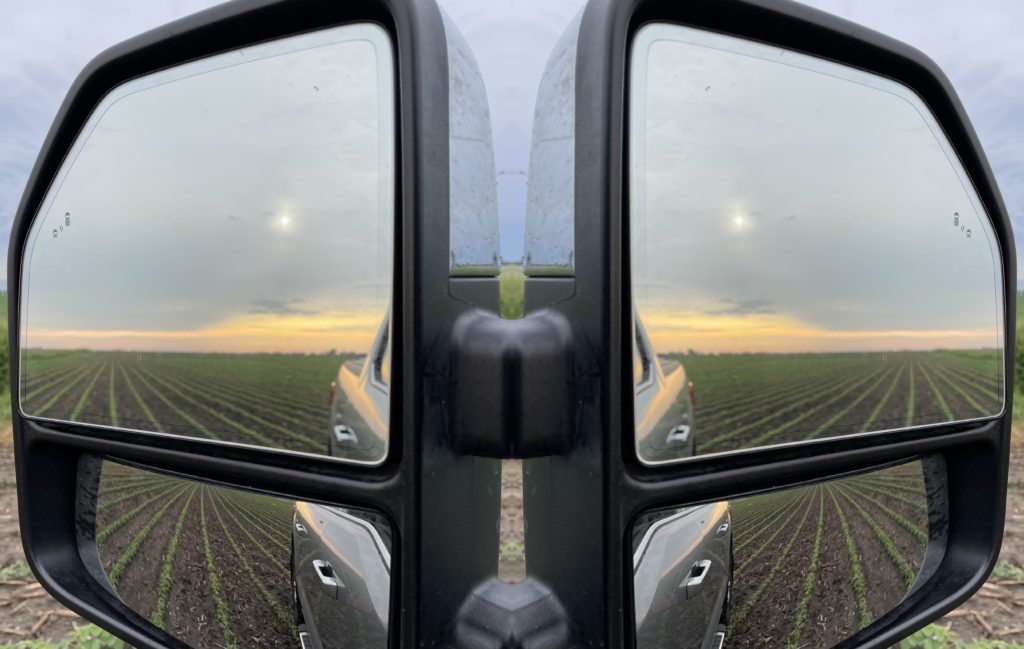By Jeff Shaner
AgVenture Regional Product Manager
This article was originally written for and published by Illinois Soy Advisor on behalf of the Illinois Soybean Association
Objects in the mirror are important, but not as important as this.
I have been making the rounds in some spiffy-looking soybean fields the past few weeks. Tilled, no-till; the early stands are there, and the outlook ahead is bright. Perhaps.
First, a quick look back at two particular hindrances where several producers met a struggle, then we will talk about a possible bright future.
Rear View Mirror Issue A)
The industry in general wrestled with seed soybeans that were lower in germ than we all prefer. You may have planted a seed lot that was tagged less than the normal 90%. If not, that somewhat better lot you received still might have dipped below 90 by the time you handled it a few times getting it in the ground. I encountered multiple folks who didn’t really make the adjustment to their planter population settings to cover for those seedlings that were never meant to be.
Rear View Mirror Issue B)
 Remember those two brief early planting windows we had in late April? Here’s what happened immediately after in the vicinity of my home area.
Remember those two brief early planting windows we had in late April? Here’s what happened immediately after in the vicinity of my home area.
The weather cooled and stayed that way for about 10 days. Not 32 degrees-or-less cool, but lows dipped to the low 40s and average temps ran well below 55 degrees. If you planted in late April, your seed absorbed moisture in early May and then was put to the test. The signature rough neighborhoods for seedling vigor included:
- Fields with heavy residue, making for soils that warmed slowly
- Portions of fields where soils were still too wet at the time of planting
- Heavy, dark soils that repel heat
- Shallow seeding depths that lacked good seed-to-soil contact
Hopefully, your field, like most others, is off to a great start like the ones pictured here.
If not, do not lose heart. Objects in the rear view are certainly important, but maybe not as important as this: your “Never Give Up On The Crop” attitude moving forward.
Midseason is near. Midseason is crucial. Midseason is when you make the decision to move forward as a money saver or a money maker. There have been instances where I have personally witnessed (in several production years and across several states) a nearly 100% beneficial return to those who decided to keep investing in their standing crop for a maximum profit outcome. When surveying your fields at midseason and anticipating a floor of say, 38 bpa in a less than desirable crop year to date, how can you flip that around into a harvesttime coupe of more like 65 bpa? It’s happened!
- Tough spring left a reduced stand? Make sure weed pressure is a non-issue. You know the usual suspects: lambsquarter, pigweed, ragweed, marestail, velvetleaf, waterhemp – and those are just the broadleaves. They’re all out to rob nutrients away from your commercial crop. However, when taking action, please consider that some herbicide families do an excellent job of eliminating weeds but can inhibit next year’s corn crop to a certain degree. Work with your agronomy advisor and walk the line between effective weed control and overall crop safety.
- Put the hammer to damaging insects. Soybeans have a tremendous ability to spring back to life later in the season after a midsummer lull. But this won’t happen if you failed to address infestations in a timely manner. I say timely, because if you are depending on someone else to make the application, by the time you observe a problem, it could be a week or more before it actually gets handled. The dirty deed is done by that point. Thrips, stinkbugs, aphids, spider mites, Japanese beetles, and Bean Leaf beetles are midseason culprits. Are you prepared to act as their populations grow toward threshold levels? Is the combination of several of them hanging at just below threshold still going to be overwhelming in total? Will one application suffice, or is a second trip warranted?
- Be diligent to the end. If your crop is still green, it is still able to add seed size in September. Watch for late arrivals to your party in the form of Corn Root Worm beetles that have fled mature cornfields, and army worms that can strip a bean field bare at a time when you most likely aren’t even aware you need to be scouting.
A midseason attitude of doom and gloom because of what hindrances you have endured so far often becomes a self-fulfilling prophecy. Prepare for 38 bpa, harvest 38 bpa. I often liken the soybean crop year to a professional basketball game. You put your best team on the floor and prepare them for competition, and then you hope they pour it on during the fourth quarter.
Unfortunately, the fourth quarter doesn’t fall in your favor if the team gets injured or in foul trouble during the mid-portion of the game. It is at this point that your positive vision of making 2022 your best year on the farm yet can absolutely be the catalyst to having a strong and healthy team pouring it on as the game draws to its conclusion, and that makes for a lot of fun when the combine rolls this fall.


